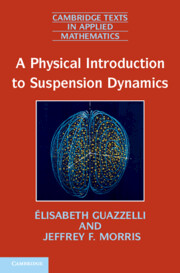Epilogue
Published online by Cambridge University Press: 05 June 2012
Summary
Finally in this book, we would like to broaden the discussion to topics where the understanding is less clear. The future of the subject will involve study of these open questions, but we do not intend to suggest that the list of topics that we are discussing is all-inclusive, or even to suggest these topics as priorities. Instead we seek to provide some indication of the scope of activities for which the concepts developed in this book may find future use.
Moving toward open questions While some of the issues discussed in the last chapters are mostly settled (or perhaps will be resolved soon), there remain greater challenges in many areas of suspension flows. We are perhaps touching on the more obvious of issues which come to mind following the exposition in the preceding chapters, and thus we likely miss novel avenues of study. Nonetheless, a list of issues in suspensions where many open questions remain includes:
Dense suspensions: Flow of suspensions approaching the maximum packing limit is often referred to as “dense suspension flow” and this condition raises special issues which we have only noted briefly in this book. In particular, for such mixtures, the particle surfaces are likely to make enduring contacts, and the details of surface roughness and friction coefficient will play a role in the behavior. How such contact forces interact with hydrodynamic lubrication forces in dense suspensions, and the relation of dense suspension flow to dense granular flow in which the interstitial fluid is a gas, are open questions of interest.
- Type
- Chapter
- Information
- A Physical Introduction to Suspension Dynamics , pp. 213 - 216Publisher: Cambridge University PressPrint publication year: 2011



